Acting Student and Bioengineering Alumna Awarded Soros Fellowship for New Americans
Awards & Accolades
By:
Published Date
By:
Share This:
Event hosted by the UC San Diego Department of Linguistics shines spotlight on Deaf culture and the department’s long history of researching and teaching ASL
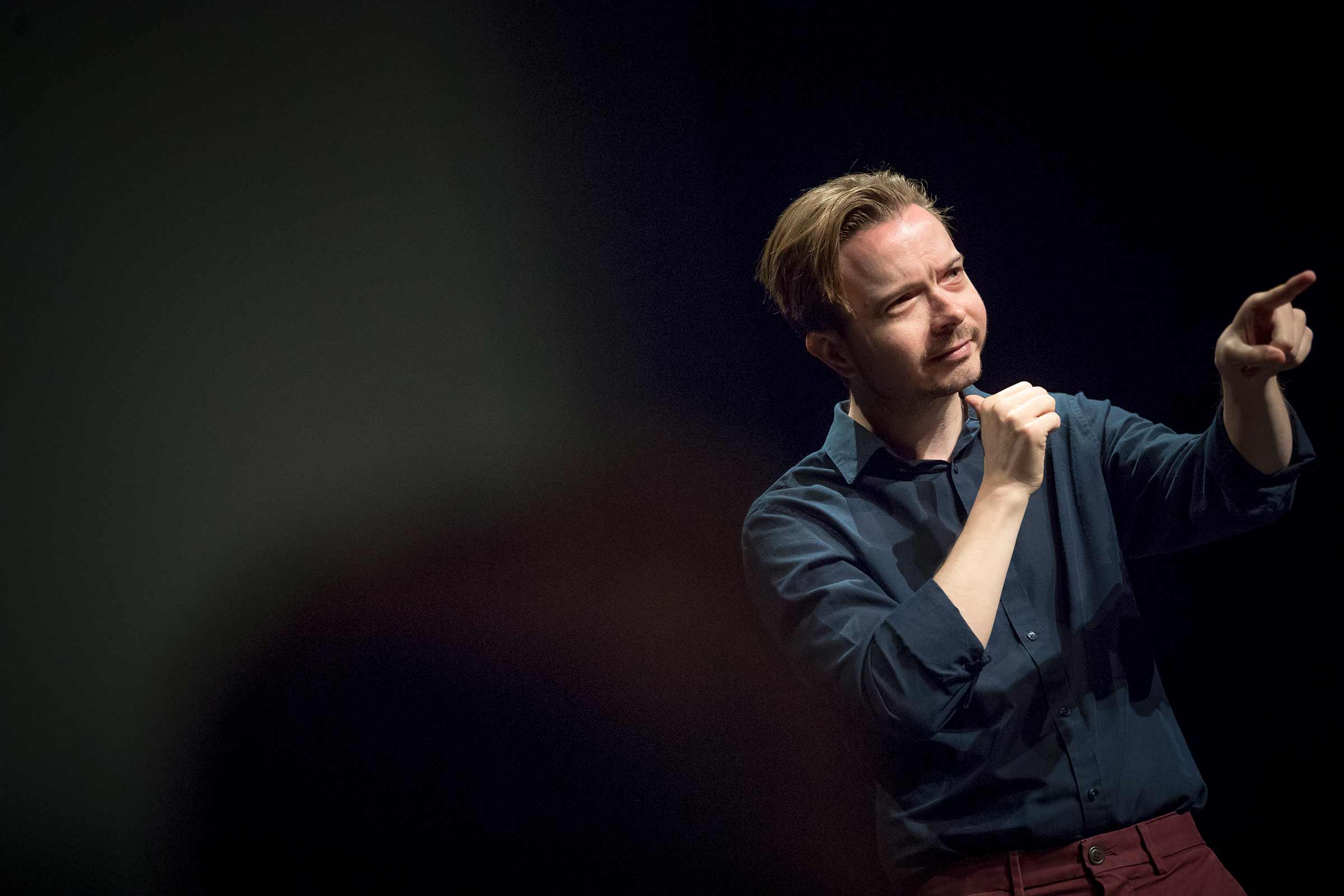
The performer Wink educates and advocates through his one-man show “Gifts From My Deaf Father.” Photos by Erik Jepsen/UC San Diego Publications
You can whisper in American Sign Language, or you can shout. You can make poetry. And if you learn ASL later in life, you might be signing with an accent forever. In most ways, it is a language just like any other, with a complex grammar, slang, dialects, the whole shebang. But in some respects, ASL is much more than just a typical language. It’s visual and kinesthetic and is an essential component of Deaf culture in the United States, too—giving signers a special bond that non-signers may not fully understand.
ASL has also been, for a long time, an important part of both research and teaching in the UC San Diego Department of Linguistics, which recently put on a two-day event celebrating Deaf culture and ASL.
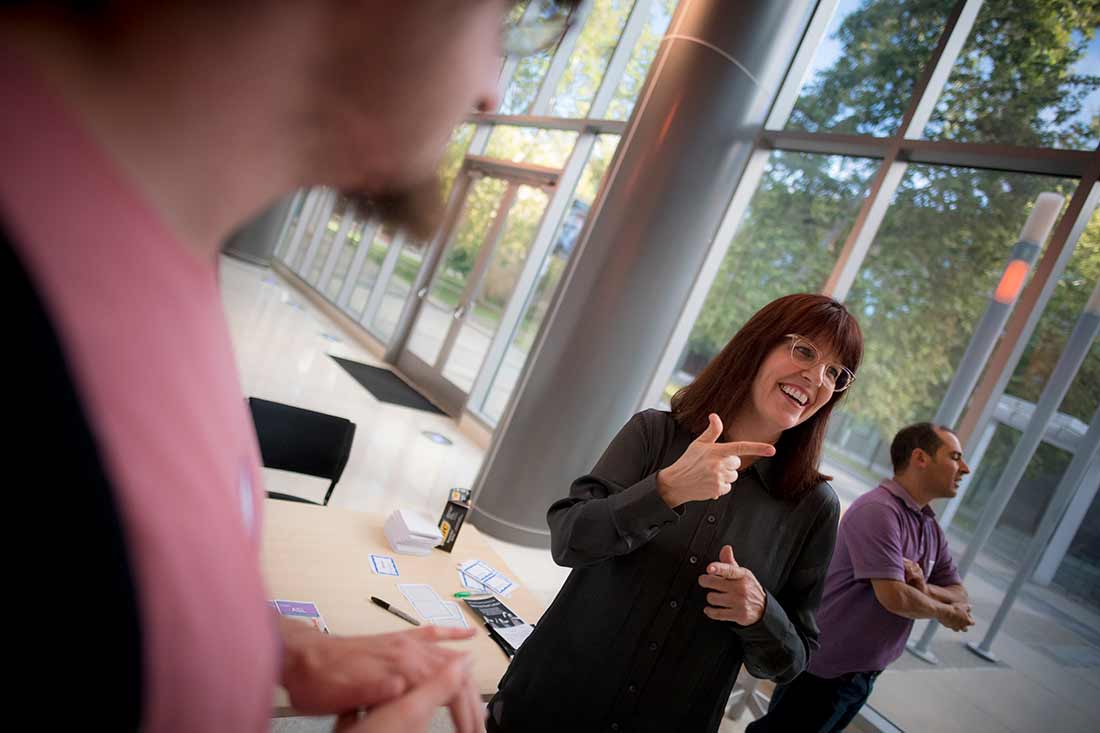
ASL is second only to Spanish in popularity on campus. Peggy Lott has been coordinating the teaching of ASL at UC San Diego for the past 20 years.
The first night of “Gifts From Deaf Culture” featured a one-man show by the performer Wink. The second night saw four members of the deaf community in a wide-ranging conversation about their diverse experiences. Both evenings were presented in ASL with interpretation into English.
“We wanted to bring awareness of Deaf culture, its richness and diversity, to campus and the wider community,” said Ivano Caponigro, associate professor of linguistics at UC San Diego, who was one of the main organizers of the event, together with Christina Knerr Frink, the department’s chief administrative officer, Peggy Lott, academic coordinator for ASL, and department librarian Cheri Radke.
“Importantly,” Caponigro said, “we also wanted hearing members of the audience—hearing people who don’t sign—to experience, for a moment, what it might be like to be deaf, what it’s like to rely on interpreters, for example, or get a joke only after those fluent in a language have already started laughing.”
The performer Wink was born after his deaf mother was in a terrible accident. Her car had been hit by a train, and she fell into a coma, while pregnant with Wink. Though she emerged and did eventually relearn ASL and regain some memories, she was never quite the same. In his one-man show, “Gifts From my Deaf Father,” Wink recounts his parents’ story in ASL from his dad’s perspective—struggling in the hospital not only with what has happened to his wife, his life but also to be understood and respected by hearing doctors and his wife’s hearing family who never learned to sign. The story is tragic, but Wink’s performance was also wickedly funny and communicated volumes about bias and ignorance on the one hand and love and resilience on the other.
Wink is a hearing person who grew up in the deaf world, with ASL as his native language. He’s now an advocate for deaf rights and a linguistics graduate student at Gallaudet University, the world’s first school for the advanced education of the deaf and hard of hearing.
On the second night of “Gifts From Deaf Culture,” Wink moderated a discussion with four members of the deaf community: UC San Diego graduate student Moises Jaramillo; local artist Claudia Jimenez, who gives ASL tours at a San Diego museum and also works at Amazon; ASL poet and instructor Rezenet Moges-Riedel; and Carol Padden, dean of the Division of Social Sciences at UC San Diego.
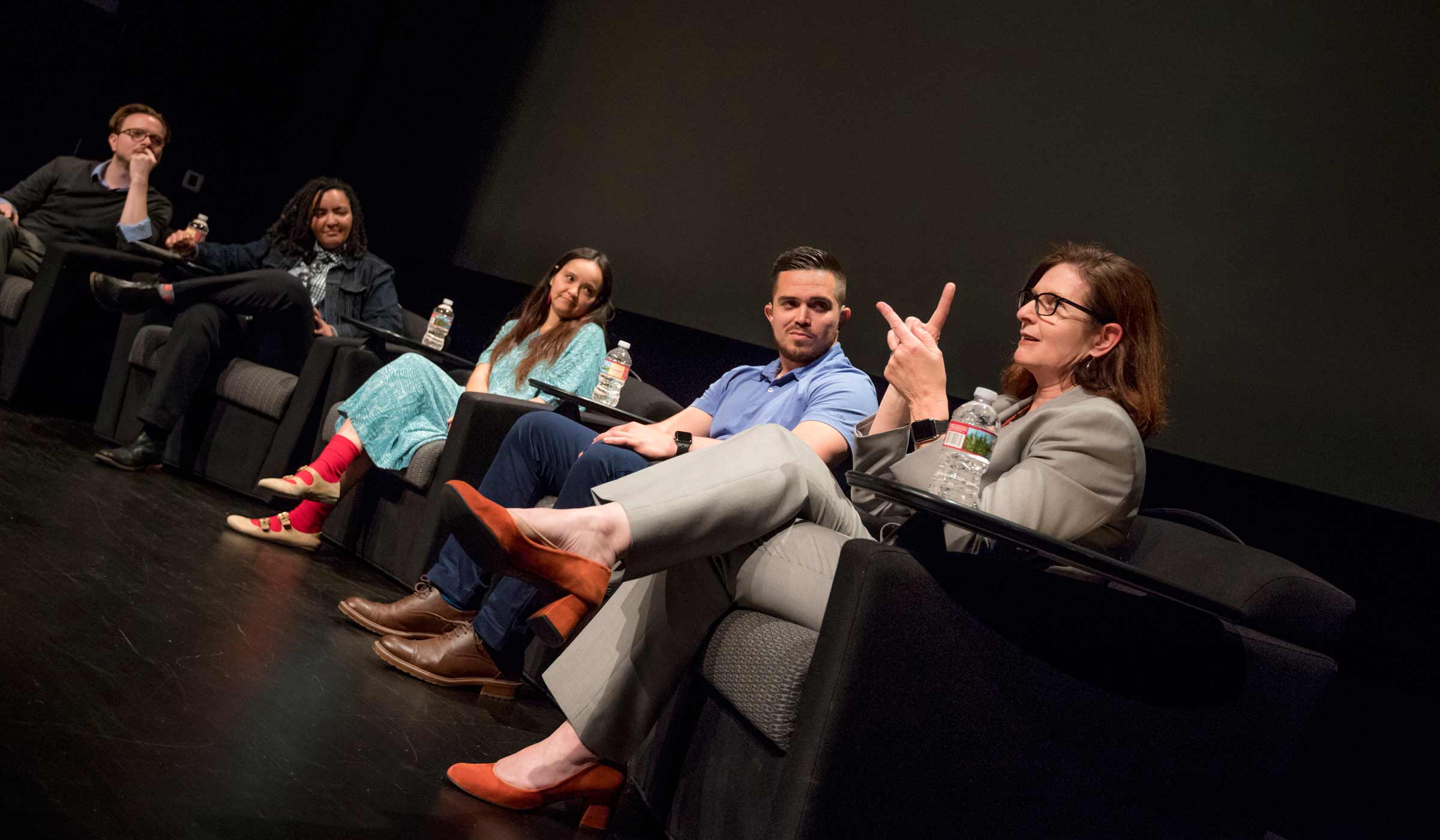
From left, moderator Wink with four members of the deaf community: ASL poet Rezenet Moges-Riedel, local artist Claudia Jimenez, UC San Diego Education Studies graduate student Moises Jaramillo and Carol Padden, dean of the Division of Social Sciences at UC San Diego.
All four (coincidentally) have older deaf siblings, and all four were unanimous in their dislike of speech therapy. All of them also cherish American Sign Language.
Asked by Wink about their layered identities, Jaramillo, who worked as a physical therapy aide before deciding to pursue a master’s in ASL-English bilingual education in UC San Diego’s Department of Education Studies, ticked off: “I’m a man, I’m Mexican, I’m deaf – I’m a signer.”
Jaramillo signed with his immediate family and used Spanish. Moges-Riedel, who teaches ASL linguistics and Deaf culture at California State University, Long Beach, signed with hers. In both their cases, though, the extended families don’t have sign language and that limited their interactions. Padden was born into a deaf family—she had deaf grandparents and is the second child of deaf parents who were professors at Gallaudet. Her early schooling was on the Gallaudet campus, at a school for deaf children. She was surrounded by ASL. Going to public school from the third grade onward, without an interpreter, was a lot like studying abroad, she said. But at the end of the day, she got to come home to Deaf culture.
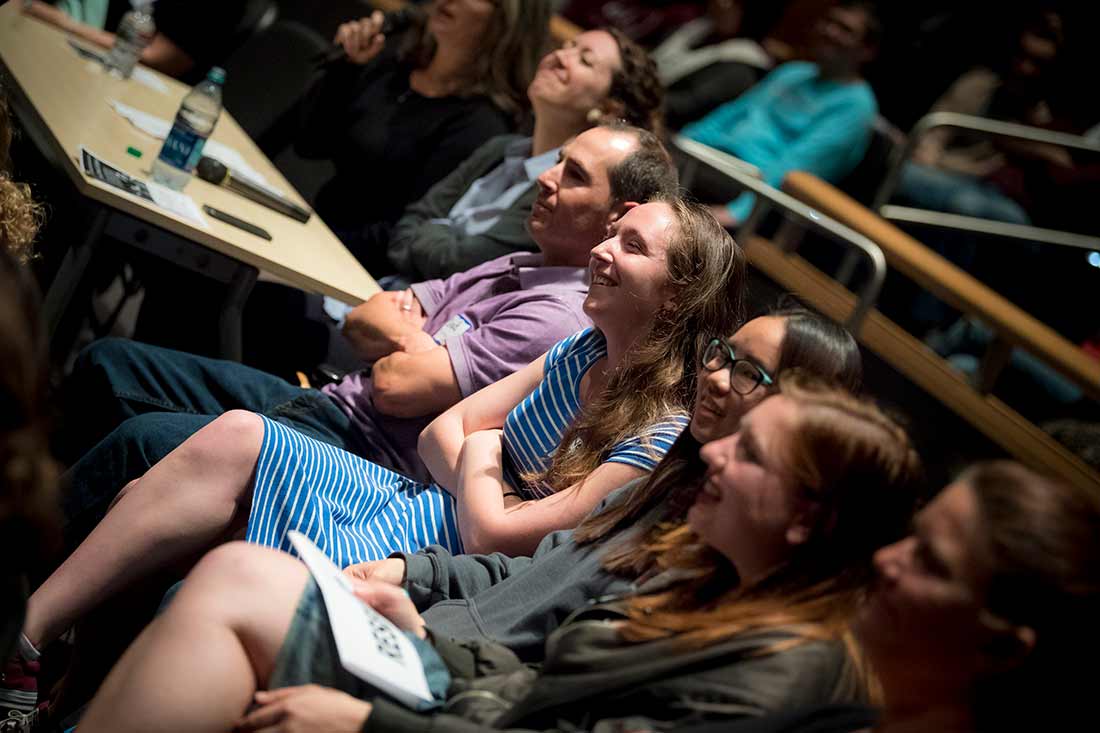
Members of the audience who know ASL experienced the event directly; those who don’t had to rely on interpreters.
Jimenez’s experience was quite different: The only person at home with whom she could sign ASL fluently was her older sister. Communication with the rest of the family was, and is, more arduous, relying on gestures, body language and what are called “home signs.”
Jaramillo empathized. “I wish,” he said at one point, “the hearing world would understand how much we have to work and work.” He told a bittersweet story about how he’d laugh along with his hearing classmates to be part of the crowd, even though the joke would only come to him late, after being relayed by his interpreter.
Being able to communicate with people in ASL, directly, not only provides access to full meaning and community, it is also a source of pleasure and beauty. Moges-Riedel recalled the joy of bedtime stories read to her in ASL by her older brother. “He was like my TV,” she said. Her mother used Signing Exact English instead of ASL, “and that was boring, put me right to sleep.”
When Moges-Riedel performed an ASL poem, the voice interpreters fell silent, and the audience was clearly moved in two ways: Those that know ASL nodded and smiled appreciatively, applauding at the end of the poem by raising hands into the air and waving them at the wrists. Those that don’t know ASL struggled to understand, but joined in with the applause anyway.
After the event, Tory Sampson, a linguistics graduate student at UC San Diego who is deaf, wrote: “The event was a huge hit—I saw how people were visibly wonderstruck by the performance and the panel. I hope this will destigmatize deafness, and embrace deaf people as contributing members of society. There will be many obstacles, yes, but teamwork (and trust!) will be key in conquering these.”
Sampson chose to study linguistics at UC San Diego because of Rachel Mayberry, she said.
Mayberry is doing groundbreaking work on sign language acquisition and what is called the “critical period” for acquiring a language. By comparing neural processes in native deaf signers, second-language learners of sign and deaf signers who came to sign language late, she is showing the harmful consequences of not learning a sign language before the critical period window closes.
An important outcome out of the Mayberry lab, say both Sampson and Sharon Rose, the current chair of linguistics, is this: All deaf children should be exposed to ASL or the sign language of their country as soon as possible.
Mayberry arrived at UC San Diego in 2008. When she did, she came to a place that had been the longtime academic home of Ed Klima (1931-2008). Klima and his wife, Ursula Bellugi at the Salk Institute, together with their students were pioneers in the study of American Sign Language. They were key figures in the recognition of ASL as a full-fledged human language and not simply a system of gestures.
In all, so far, there have been 14 doctoral dissertations on sign languages produced in UC San Diego’s Department of Linguistics. The first was by Nancy Frishberg in 1976, on the historical development of signs in ASL. The most recent is by Hope Morgan, in 2017, on the phonology of Kenyan Sign Language.
Carol Padden, the university’s current dean of Social Sciences, also wrote her dissertation here. Working with Klima and Bellugi, as well as David Perlmutter in the late 1970s and early ’80s, she wrote on the syntax and morphology of ASL. A professor in UC San Diego’s Department of Communication since 1983, Padden won the prestigious MacArthur “Genius Award” in 2010 for her sign language scholarship. She was cited for illuminating “the specific social implications of signed communication” and for her work on ASL and on ABSL, an emerging language in Israel’s Negev desert called Al-Sayyid Bedouin Sign Language.
“Sign languages are more widely studied than when I began,” said Padden, who also holds the Sanford I. Berman Chair in Language and Human Communication. “Sign language linguistics has grown and blossomed—change that was in part due to the outstanding work that has been produced at UC San Diego over the years.”
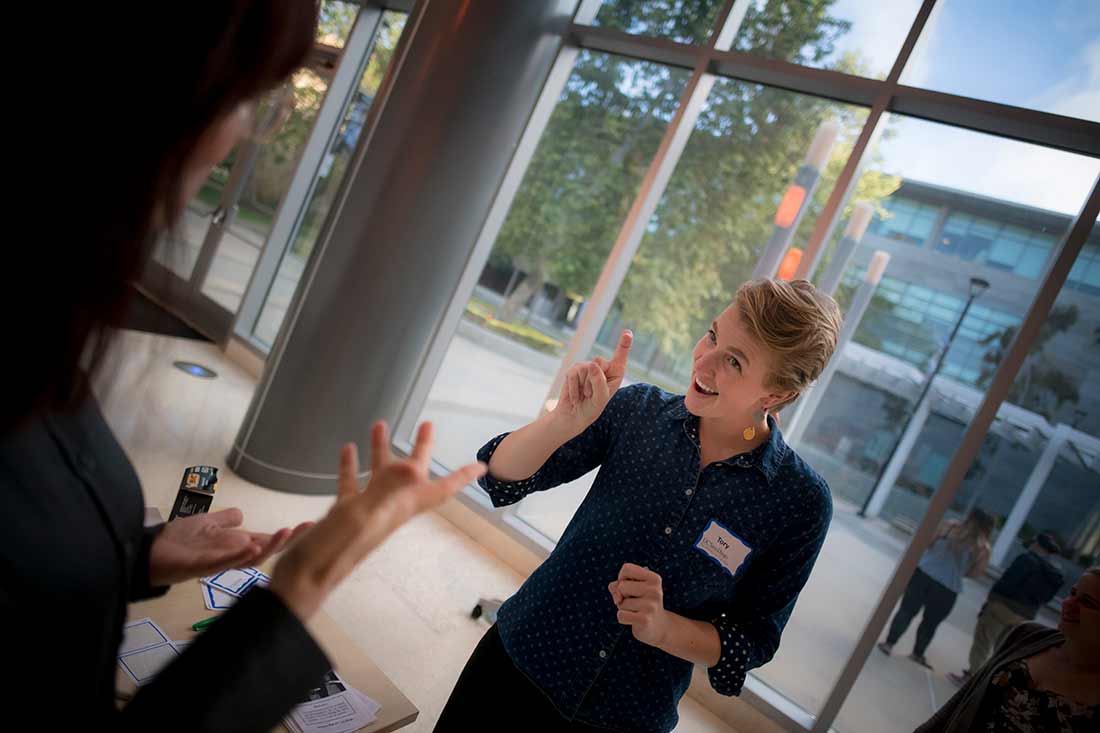
Linguistics graduate student Tory Sampson, who is deaf, has joined Rachel Mayberry’s lab – the latest addition to a long history of sign language scholarship at UC San Diego.
UC San Diego has also been a leader in the teaching of ASL. One of the first major research universities to offer ASL instruction and count it for second-language credit, UC San Diego is widely recognized for its exemplary ASL classes, said Peggy Lott, who has been academic coordinator of ASL at UC San Diego for the past 20 years or so.
ASL instruction is intensive. There are nine deaf instructors. And like in all the other languages taught by the Linguistics Language Program, students of ASL take classes five days a week: conversation on Mondays, Wednesdays and Fridays; language analysis on Tuesdays and Thursdays. Each year, about 250-300 students study ASL at UC San Diego. ASL is second only to Spanish in popularity on campus.
You can also minor in ASL, taking such classes as “Sign Language and Its Culture” and “Psycholinguistics of Sign Languages,” taught by Mayberry—or “ASL Poetry and Performance” and “Sociolinguistics in Deaf Communities,” both of which are taught by Lott in ASL.
In Summer 2019, Lott plans to offer the university’s first Global Seminar in sign language, “Sign Language Studies in Paris,” which will take students back to the roots of ASL (in France) and also include studies of Native American Sign Language and Black ASL.
Lott is hearing. But she’s “a lucky hearing person,” she said. “Because a long time ago, when I was a child, I met a woman who is deaf—and I became fascinated with her language. Communicating visually is so…enriching. It’s opened my mind in so many ways.”
Students taking ASL often tell Lott it’s their favorite class. She thinks it’s because it stretches them and “they realize just how much creativity is available in the language.”
In addition to the Department of Linguistics, “Gifts From Deaf Culture” was made possible by: the Department of Anthropology, the Department of Communication, the Division of Social Sciences, the Graduate Student Association, and the Office of the Vice Chancellor for Equity, Diversity, and Inclusion at UC San Diego.
Share This:
Keep up with all the latest from UC San Diego. Subscribe to the newsletter today.